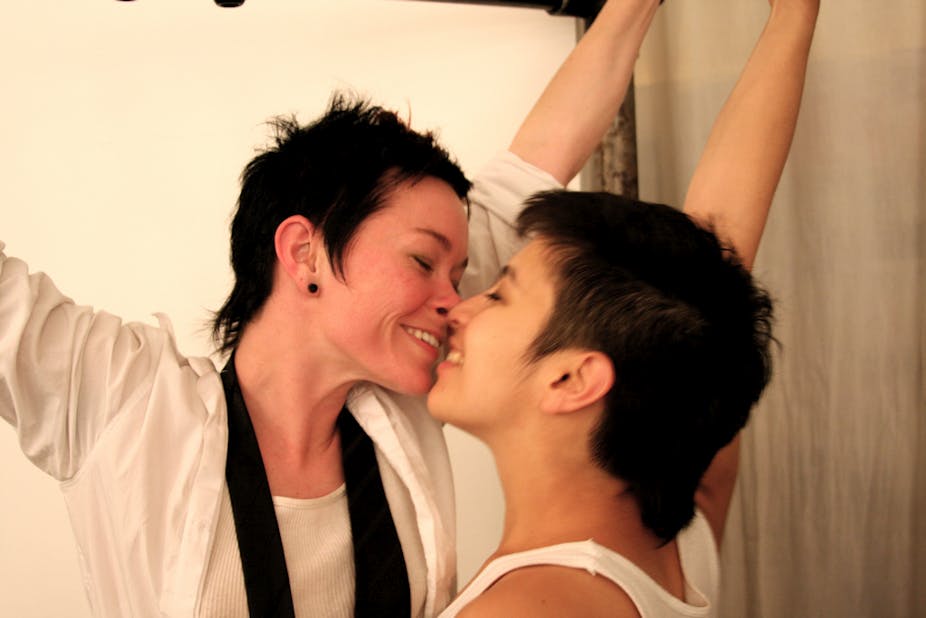I was recently approached by a young journalist, who asked for my comments on the Feminist Porn Awards.
In the course of the interview, she asked if I thought feminists should watch porn. I replied that watching porn is, to my mind a personal choice, and “should” didn’t come into it.
Feminist responses to porn reflect the diversity of feminist responses to sexuality in general.
These include not just responses to the physical act of sex, but to representations of sex and sexuality in words and pictures.
For all the self-identified feminists who reject pornography, there are plenty more who enjoy watching it. Some even make their own.
Between 2001 and 2003 I worked with a team interviewing a range of Australian DIY, cottage industry and ‘hobbyist’ porn producers, as part of the Australian Research Council funded Understanding Pornography in Australia project. Most were women, and all of them were intensely aware of feminist debates around pornography.
In fact, some had made the decision to bring a different erotic or aesthetic approach to porn through their feminist politics.
This approach was most intensely expressed by the queer and lesbian porn producers who funded their efforts with tax-refund cheques and the proceeds of community fundraisers.
For this group, porn production was part of a range of avant-garde “community arts” that combined live performances, dance parties and political activism.
The aim for these producers was to simultaneously express their sexual politics, represent their subjective experience of sexuality, and document a collective sexual sub-culture.
That’s not to say that all our interviewees regarded themselves as artists. A number of them also worked in the mainstream sex industry, and identified as sex-workers.
For these women, feminist debates around pornography intersected with debates around sex as work, and they were fiercely articulate in regard to their working conditions, and their experiences of stigma and discrimination in both feminist and non-feminist circles.
Although most of the women we interviewed were under 30, they didn’t identify as “post-feminist”, and they weren’t part of a “raunch culture” backlash.
On the contrary, they understood their efforts at sexual self-representation as part of a historical trend within what’s been termed second-wave feminism. These young feminists explicitly paid homage to Australian feminist porn producers like Wicked Women’s Kimberly O’Sullivan, and US feminists like Betty Dodson, Carol Queen and Susie Bright.
In doing so, they recognised that contemporary “feminist porn” did not emerge in spite of criticisms of the mainstream commercial porn industry, but because of them. As Bright herself expressed in her nuanced eulogy of anti-porn activist Andrea Dworkin:
Here’s the irony… every single woman who pioneered the sexual revolution, every [second-wave] erotic-feminist-bad-girl-and-proud-of-it-stiletto-shitkicker, was once a fan of Andrea Dworkin. Until 1984, we all were. She was the one who got us looking at porn with a critical eye, she made you feel like you could just stomp into the adult bookstore and seize everything for inspection and a bonfire.
When they had finished dancing on their bonfires, Bright and her peers decided to take their critique a step further, and engage the same DIY spirit that had led to start-ups of Women’s Health Centres.
This time, they were responding not to a male-dominated health-care system, but a male-dominated porn market-place. The result was the early feminist porn magazine On Our Backs, and a successful (and very rapidly mainstreamed) boom in “women’s erotica” and “couples porn” videos.
Just as not all women are feminists (and not all feminists are women) it’s fair to say that not all “women’s erotica” or “couples porn” has a feminist agenda.
Sexual texts are not always easy to read at face value, especially when the viewer doesn’t know how or where the image was produced. For some viewers, the context of production is not important – it’s the action onscreen that counts.
Should feminists watch porn? Should they oppose it? The answer to that question often depends on their understanding of feminism.
My interviewees called themselves feminist pornographers because they tried to integrate communication, safety, pleasure and consent into representations of hot erotic fantasy encounters.
Some produced their words and images for a niche audience, others for mainstream porn production houses, but all were self-reflexive about why and how they made porn.
Feminist pornography is characterized by concern not just for the aesthetics of sexual representation, but for sexual ethics and politics, too.

